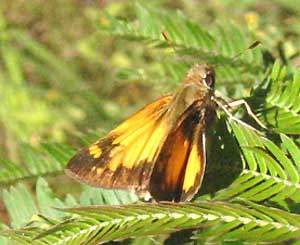Excerpts from Jim Conrad's
Naturalist Newsletter
from the January 21, 2008 issued from Yerba Buena Clinic just outside Pueblo Nuevo Solistahuacan, Chiapas, MÉXICO
about 1740 meters in elevation, ± LAT. 17° 11' 27"N, LONG. -92° 53' 35"W
SKIPPERS
The other day I photographed the skipper shown below.

The neat thing about that picture is that is shows the most obvious features that make a skipper a skipper.
First of all, skippers are thought of as a kind of butterfly. Taxonomically, skippers are members of the family Hesperiidae, of which Mexico is home to about 788 species.
As the picture shows, skippers differ from most other butterflies in that their head, thorax and abdomen are massive, while their wings are proportionately small. Their antennae arise far apart atop their broad heads and their antennae are often tipped by a slender, tapering, hook called the apiculus. Because their heavy bodies are borne by such small wings, instead of flitting and gliding like other butterflies, they dart or "skip" about in fast, jerky flights, hence the name.
Often resting skippers hold their wings at in-between angles instead of horizontally like moths, or directly over their backs like other butterflies. Sometimes, as in the picture, their forewings are held at one angle while their hindwings are at another, giving the skipper the look of an F-22 Raptor fighter jet. I doubt that this aerodynamic similarity between skipper and fighter-jet is coincidental.
Since people at the {now defunct} Mariposas Mexicanas website (Mexican Butterflies) have been identifying my butterfly pictures, I've been surprised by what a large percentage of our butterflies turn out to be skippers. I've even set up a special page just featuring "Skippers of Upland Chiapas," accessible at www.backyardnature.net/chiapas/butter02.htm.
You may notice that the skipper in my picture isn't featured on that page. That's because so far the Mariposas Mexicanas experts have been unable to identify it. The Skipper Family is not only huge but also probably the hardest to identify of all butterfly groups. Often identification is impossible without microscopic examination of male genitalia. My old Peterson Fieldguide says that "...in some groups positive identification of every specimen is a practical impossibility."